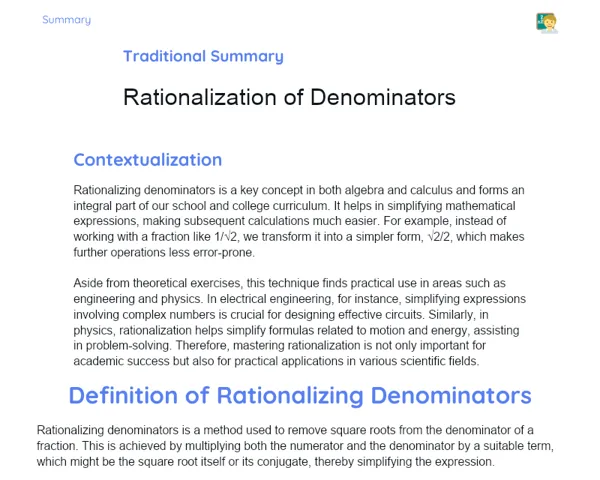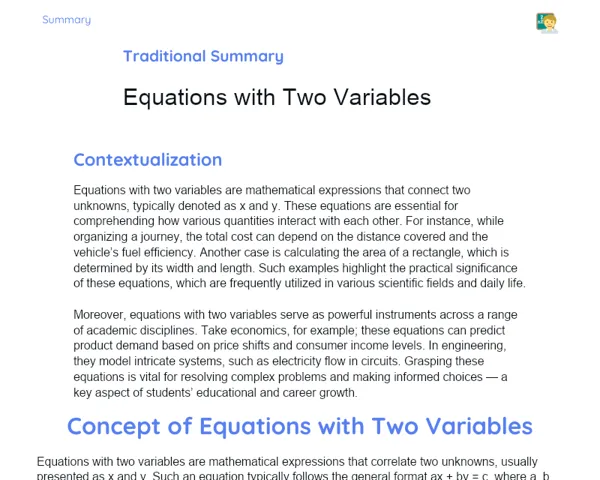Summary Tradisional | Area and Perimeter: Comparison
Contextualization
Mathematics plays a crucial role in our everyday lives, often in ways we might not immediately recognize. For instance, when we need to measure plots of land, calculate the materials required for construction, or even while arranging a room, mathematics is at play. Hence, grasping the concepts of area and perimeter is vital. These principles are cornerstone to various practical tasks like architectural designs, garden layout planning, and even sports activities.
The perimeter refers to the total length of all the sides of a shape, while the area measures the space contained within that shape. Being able to compute these measurements is essential for tackling real-world challenges efficiently. For instance, architects utilize area and perimeter calculations to design buildings, determining how much square footage is required for each room and the amount of materials necessary for constructing walls and fences. This highlights the practicality and applicability of area and perimeter in the real world.
To Remember!
Definition of Perimeter
The perimeter is a crucial measurement that signifies the total length around a geometric shape. It is measured linearly, using units such as centimeters and meters. For uncomplicated shapes like squares and rectangles, calculating the perimeter is simple: just add up all the sides. For example, to find the perimeter of a square, you multiply the length of one side by four, as all sides are the same length. For rectangles, you add two times the width and two times the length.
When it comes to shapes like triangles, the process is similar: you add up the lengths of all sides. In the case of an equilateral triangle, where all sides are equal, the perimeter is three times the length of one side. For scalene and isosceles triangles, knowing the length of each side is essential to perform proper addition.
Understanding the perimeter is significant in numerous practical situations. For instance, when someone wishes to fence a plot of land, calculating the perimeter is key to determining how much material will be needed. Similarly, when it comes to interior decoration, the perimeter helps to ascertain the length of baseboards or moldings.
-
The perimeter is the sum of all the sides of a geometric shape.
-
It is a linear measurement, given in units of length.
-
It serves various practical purposes, like fencing land and interior decoration.
Definition of Area
The area measures the surface space within a geometric figure. Unlike perimeter, area is expressed in square units, such as square centimeters and square meters. Each shape has a particular formula for calculating its area. For squares, the area is found by squaring the length of one side. In a rectangle, we simply multiply the width by the length.
For triangles, the area is calculated using the formula: (base * height) / 2. This holds true for any type of triangle, whether equilateral, isosceles, or scalene. In the case of more complex shapes such as irregular polygons, you may need to break the shape down into simpler components, calculate their areas separately, and then total them up.
Grasping the notion of area is critical for various applications. Architects and engineers frequently calculate areas to estimate material requirements for construction projects. Farmers, too, apply area calculations for effective crop planning on their fields. Additionally, understanding area proves useful in everyday tasks, like estimating paint needed to cover a wall or the flooring required for a room.
-
The area measures the internal surface of a geometric shape.
-
It is denoted in square units.
-
Each geometric shape has its own specific formula for calculating area.
Comparison Between Area and Perimeter
While area and perimeter relate to geometric shapes, they represent distinct concepts and serve different purposes. The perimeter outlines the length around a shape, whereas the area quantifies the internal surface of that shape. An intriguing fact is that shapes can have the same perimeter but differ in area; for instance, a square and a rectangle could share identical perimeters while exhibiting different areas, depending on their side ratios.
This distinction is crucial in many practical contexts. For example, when planning to enclose a garden, the perimeter dictates the length of fencing required, while for planting grass or flowers, the area measures the available planting surface. Understanding these nuances allows for more informed and effective decision-making across various scenarios.
Furthermore, recognizing the link between area and perimeter is fundamental to solving academic mathematics problems and enhancing critical thinking skills. Through practical instances and exercises, students can learn to apply these concepts proficiently, improving their problem-solving abilities and deepening their appreciation of mathematics as it connects to real-life situations.
-
Area and perimeter are related but represent different concepts.
-
Shapes with the same perimeter can have varying areas.
-
Understanding the difference between area and perimeter is essential for practical applications.
Formulas Used
To compute the perimeter and area of geometric figures, specific formulas are utilized. For perimeter, the formulas are often straightforward. For a square, the perimeter is 4 times the length of one side (P = 4 * side). For rectangles, the formula combines twice the width and twice the length (P = 2 * width + 2 * length). For triangles, you sum the lengths of all sides (P = side1 + side2 + side3).
The area formulas also vary by shape. For a square, the area is found by squaring one of its sides (A = side * side). For a rectangle, the area is calculated by multiplying width by length (A = width * length). For triangles, the area is derived from the formula (A = (base * height) / 2). Mastering these formulas is key for tackling mathematical problems and applying knowledge of area and perimeter practically.
It's paramount for students to memorize these formulas and comprehend their application. Consistent practice helps reinforce this knowledge, making it easier to use in different contexts. Additionally, grasping the reasoning behind these formulas, such as breaking down complex shapes into simpler ones, can significantly enhance students' understanding of geometry and mathematics overall.
-
Specific formulas are utilized for calculating perimeter and area of geometric shapes.
-
For perimeter: square (P = 4 * side), rectangle (P = 2 * width + 2 * length), and triangle (P = side1 + side2 + side3).
-
For area: square (A = side * side), rectangle (A = width * length), and triangle (A = (base * height) / 2).
Key Terms
-
Perimeter: The total length around a geometric shape.
-
Area: The measure of the internal surface area of a geometric shape.
-
Square: A shape with four equal-length sides.
-
Rectangle: A shape with equal lengths on opposite sides.
-
Triangle: A shape with three sides.
-
Units of Measurement: Centimeters, meters, square centimeters, square meters.
-
Formulas: Mathematical expressions for calculating perimeter and area.
Important Conclusions
In this lesson, we explored how to determine the areas and perimeters of basic geometric shapes like squares, rectangles, and triangles. The perimeter is simply the added lengths of all the sides, while the area quantifies the space within the shape. Each geometric form has its own formula pertinent to these calculations, which are vital for addressing both theoretical and practical challenges.
Understanding the differences between area and perimeter is critical, as shapes can share the same perimeter yet differ in area, and vice versa. Such knowledge is applicable in numerous daily scenarios including construction, decoration, and layout planning. Professionals such as architects and engineers rely heavily on these concepts in their work.
We highlight the significance of memorizing and adeptly applying the formulas for area and perimeter, alongside comprehending the rationale behind these computations. Regular practice through varied exercises is key to solidifying this knowledge and effectively applying it across different contexts.
Study Tips
-
Practice area and perimeter calculations using various geometric figures to reinforce learning.
-
Incorporate visual aids such as sketches and 3D models to better grasp area and perimeter concepts.
-
Engage with real-world problems involving area and perimeter calculations, such as room decoration planning or estimating materials needed for a garden enclosure.



